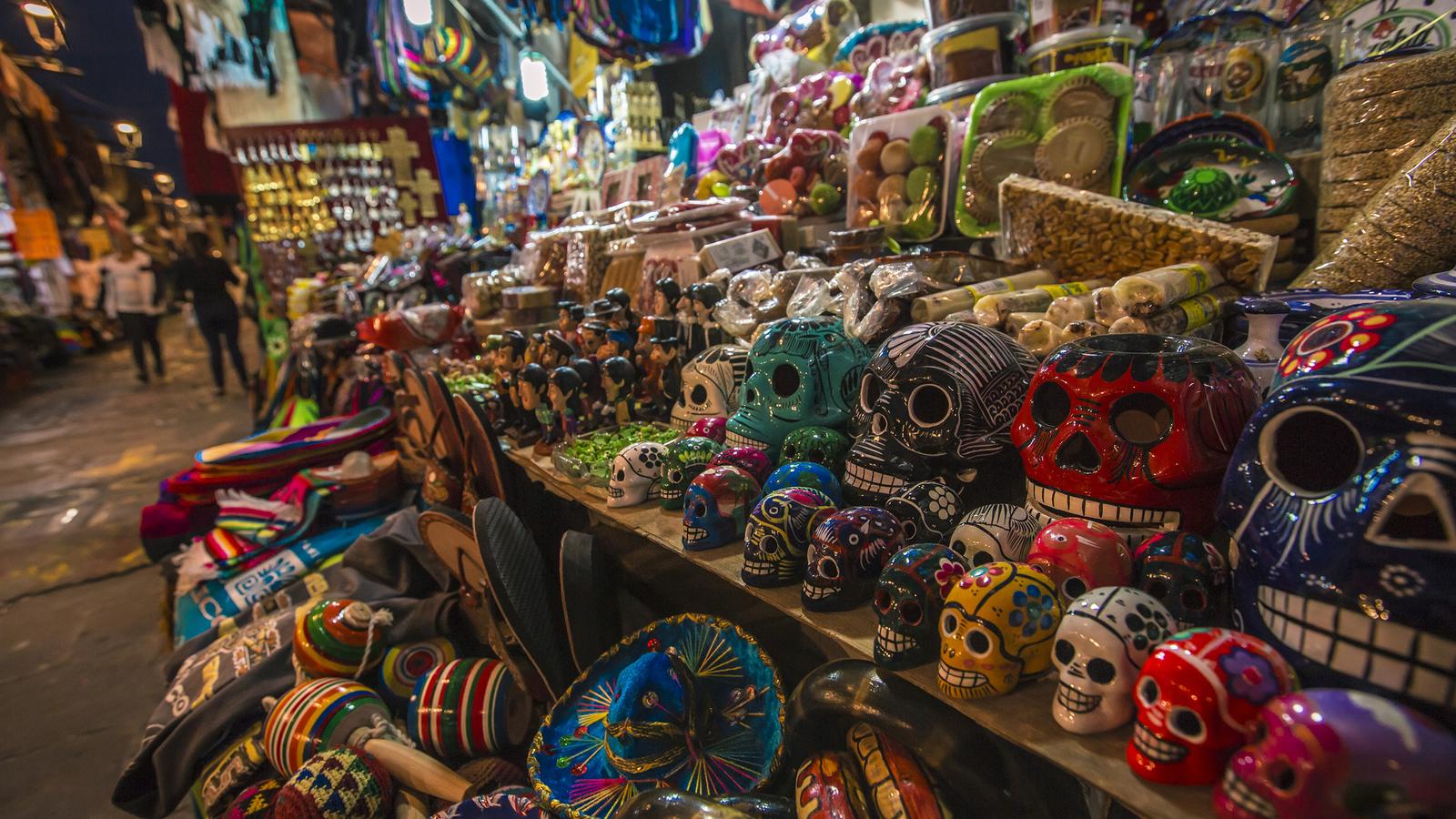The Captivating Imagery of Day of the Dead in Mexico
Journey into the captivating world of Mexico’s Day of the Dead, where death is celebrated with vibrant colors, lively music, and heartfelt traditions. This festival is a symphony of remembrance and a reminder that even in the face of mortality, joy and creativity can prevail. Read on to explore the stunning imagery of altars adorned with marigolds, the intricate designs of sugar skulls, and the vibrant costumes that transform Day of the Dead into a feast for the eyes and a celebration of the human spirit.
Decoding the Visual Language of Día de los Muertos
Picture this: A country bursting with color, a joyous celebration, and the air thick with the scent of marigolds. This isn’t just any party – it’s the Day of the Dead, or Día de los Muertos, in Mexico. It’s a time when families and friends gather to remember and celebrate the lives of those who’ve passed on. And the way they do it? Through some of the most captivating and symbolic imagery you’ll ever see.
Let’s dive into the heart of it all, shall we?
Ofrendas: Altars of Love and Remembrance
Imagine walking into a home and seeing a beautifully decorated altar, glowing with candles and overflowing with offerings. This, my friends, is an ofrenda. It’s not about mourning; it’s about welcoming loved ones back for a visit. Families meticulously arrange their loved one’s favorite foods and drinks, alongside flickering candles, vibrant cempasúchil (marigolds), and intricately decorated sugar skulls. Each item is carefully chosen, a testament to the life they’re celebrating.
Calaveras: Playful Skulls, Celebrating Life
Now, let’s talk about those skulls. Not your average, everyday skulls, mind you. These are calaveras – playful, colorful representations of life and death intertwined. You’ll see them everywhere, especially the sugar skulls – delicate, adorned with names, and placed lovingly on the ofrendas. They’re not meant to be morbid; they’re actually a celebration of life, a whimsical reminder that death is just another stage in the journey.
Face Painting: Merging Life, Death, and Heritage
The celebration isn’t complete without a little transformation, right? During the Day of the Dead, people paint their faces to resemble skulls, a tradition deeply rooted in honoring their ancestors. Some designs are simple, others elaborate works of art, but they all symbolize the merging of life and death, the present and the past. It’s a powerful way to connect with their heritage and participate in this vibrant celebration.
Marigolds: Guiding Lights and Aromatic Offerings
Remember those marigolds we mentioned earlier? These aren’t your average flowers. The cempasúchil, with their brilliant orange hues and captivating fragrance, are believed to guide the spirits of loved ones back home. You’ll see them everywhere – decorating ofrendas, scattered on gravesites, their petals forming paths for spirits to follow. Their aroma is part of the magic, adding another layer to the sensory experience of the Day of the Dead.
Feasts for the Soul: Food and Tradition
No celebration is complete without a feast, and the Day of the Dead is no exception! One of the stars of the show is pan de muerto– the “bread of the dead.” This sweet bread, often adorned with bone-like decorations, is baked with love and placed on ofrendas as a special treat for returning spirits. And it’s not just the bread; traditional dishes like mole, tamales, and atole fill the air with tempting aromas, inviting everyone to share in the celebration.
Costumes: Dancing with Death, Celebrating Life
Imagine a parade of skeletons, not scary, but elegantly dressed, dancing in the streets. This is the Day of the Dead! People dress up as skeletons, the iconic Catrina figures, or other representations of death. It’s not about fear, but about embracing the cycle of life and death, celebrating the memories of those who are gone. The costumes are often elaborate, full of color and tradition, a testament to the vibrancy of Mexican culture.
A Celebration of Life, Remembered
The images of the Day of the Dead might seem unusual at first, but they hold a powerful message. They tell a story of life and death, intertwined and celebrated, reminding us that our loved ones are never truly gone as long as we keep their memory alive. It’s a celebration, a remembrance, and a testament to the enduring strength of the human spirit.
Unveiling the Soul of Día de los Muertos: What Does It Represent?
Now that we’ve touched on what Day of the Dead looks like, let’s dive a little deeper into what it actually means to the people of Mexico. It’s not just about sugar skulls and skeletons, you see. It’s about family, remembrance, and celebrating life, even after death.
You could say it’s kind of like a big reunion, but instead of catching up over coffee and cookies, families build altars (or ofrendas) adorned with photos, favorite foods, and mementos of their loved ones who have passed on. It’s their way of inviting their spirits back for a visit, to share in the festivities and be a part of the family once more.
There’s a strong belief that death isn’t the end, but just another stage in the journey of life. So, while there’s a sense of sadness for those no longer physically present, the Day of the Dead focuses on celebrating the lives they lived and the memories they left behind. It’s a beautiful blend of joy and sorrow, remembrance and celebration, all woven together with vibrant colors, lively music, and the enduring love of family.
Beyond the Face Paint: A Complete Day of the Dead Fashion Guide for Mexico
You’ve got your itinerary set for Day of the Dead in Mexico, but have you figured out your outfit yet? Remember, this isn’t about mourning; it’s about celebrating the lives of those we’ve lost. That means embracing a vibrant and colorful dress code that honors the joyous spirit of the occasion.
Ladies First: Traditional Elegance
For women, a beautiful and traditional option is a Puebla dress. These dresses are known for their lively colors and intricate embroidery, which truly capture the festive mood. And the best part? They come in long, flowing styles that are both elegant and comfortable.
Adding a Touch of Flair: Accessories
No Day of the Dead outfit is complete without some eye-catching accessories. A crown of bright and cheerful flowers is a must-have. It symbolizes life and renewal, adding a touch of beauty to your ensemble. And to top it all off, consider a hat adorned with even more flowers and delicate lace.
The Language of Color: Hues and Blooms
Speaking of color, don’t shy away from vibrant shades of orange, yellow, and purple. These hues are synonymous with the joy and energy of this special celebration. You can incorporate them through your clothing, accessories, or even with floral accents – the more, the merrier!
Gentlemen, It’s Your Turn: Men’s Fashion
For men, there are some equally stylish options. A classic choice is the charro suit, a traditional outfit that exudes Mexican heritage. If you’re looking for something a little more contemporary, a handsome embroidered shirt paired with dark pants is always a winner.
A Note on Respect: Cultural Sensitivity
While it’s tempting to go all out with costumes, it’s essential to be mindful of Mexican culture. Costumes that mock or stereotype are never appropriate. Instead, focus on attire that celebrates the true traditions and beliefs associated with the Day of the Dead. Remember, it’s about honoring loved ones and participating in a beautiful cultural celebration.
Beyond the Grave: Unveiling the Top Experiences for Day of the Dead in Mexico
Picking the “best” spot for Day of the Dead in Mexico is kinda like trying to choose your favorite taco – there are just SO many delicious options! Whether you dig the energy of massive parades or the quiet beauty of candlelit vigils, Mexico’s got a Day of the Dead experience with your name on it.
Let’s break down a few top contenders:
If you’re all about that big city buzz…
- Mexico City is calling your name. Imagine colossal parades with giant skeletons grooving down the street, elaborate altars bursting with color, and a fiesta atmosphere that’s impossible to resist. It’s Day of the Dead with a side of urban excitement.
For a taste of tradition that runs deep…
- Oaxaca is where it’s at. This region is practically synonymous with Day of the Dead, and you’ll feel it everywhere you go. Think vibrant markets overflowing with marigolds, intricate decorations adorning every corner, and a connection to ancient customs that’s truly special.
Seeking a more intimate, spiritual vibe?
- Michoacán, particularly the island of Janitzio, offers a glimpse into the heart and soul of Day of the Dead. Picture this: families gathering in candlelit cemeteries, sharing stories and offerings with loved ones who have passed. It’s a deeply moving experience that showcases the true essence of the celebration.
But wait, there’s more! Mexico’s got a whole buffet of hidden gems for Day of the Dead adventurers:
San Juan Chamula (Chiapas): Tucked away in the highlands, this indigenous village offers a peek into the ancient Mayan roots of Day of the Dead. Think rituals steeped in tradition and a unique cultural perspective that’s truly eye-opening.
Mixquic (near Mexico City): This charming town is basically synonymous with cemetery vigils. As the sun sets, families gather among the tombs, their flickering candles painting the night with an ethereal glow. It’s a mesmerizing blend of celebration and remembrance.
Mérida (Yucatán): Ever heard of Hanal Pixán? This Mayan version of Day of the Dead has its own special flavor, with unique traditions and dishes that reflect the region’s rich heritage.
So, how do you choose?
- Think about your vibe. Do you crave the energy of a crowd or the quiet intimacy of a smaller gathering?
- Do a little digging into local customs. Each region has its own way of celebrating, and understanding those nuances will enhance your experience.
- Book your accommodations early! Day of the Dead is a hot ticket, and you don’t want to be left without a place to crash after a long day of festivities.
No matter where you end up, Day of the Dead in Mexico promises to be an unforgettable journey – a chance to witness a vibrant culture honoring life and death with equal passion and joy.
Have you ever wondered how old would Marilyn Monroe be today? Well, if she were alive, click on the link and find out! And if you’re interested in seeing images of Pompeii, we’ve got plenty of those too!
- SYBAU See You Baby Meaning: Gen Z Slang Evolves - July 1, 2025
- Unlock Your Inner Youth: Lifestyle Secrets for a Vibrant Life - July 1, 2025
- Decode SYBAU Meaning: Gen Z Slang Explained - July 1, 2025







1 thought on “The Captivating Imagery of Day of the Dead in Mexico”
Comments are closed.